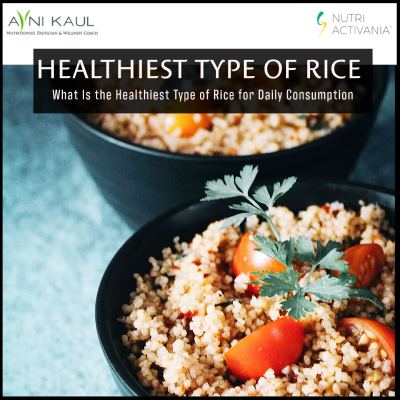
Rice, a staple food for billions worldwide, is a versatile grain that comes in multiple types and colours, each offering distinct nutritional benefits. However, when it comes to selecting the healthiest rice for daily consumption, several factors need consideration, including nutrient content, processing methods, and individual dietary needs says the leading weight loss expert and dietician in Delhi, Avni Kaul, in this blog.
Brown Rice – Brown rice is mostly hailed as one of the healthiest varieties due to its minimal processing. Unlike white rice, brown rice retains its outer bran layer, which is rich in fibre, vitamins, and minerals. This layer contains nutrients such as magnesium, phosphorus, selenium, thiamine, niacin, and vitamin B6. Moreover, its high fiber content aids digestion, promotes satiety, and helps regulate blood sugar levels, making it an excellent choice for individuals managing diabetes or seeking weight management.
Wild Rice – Wild rice, although technically not a kind of rice but rather a grass seed, is nutrient-dense and offers unique health benefits. It is higher in protein and fibre compared to white rice, making it a suitable option for vegetarians and vegans looking to increase their protein intake. Additionally, wild rice contains antioxidants, such as anthocyanins and flavonoids, which help combat inflammation and reduce the risk of chronic diseases like heart disease and cancer. Its distinct nutty flavor adds depth to dishes and enhances culinary diversity.
Black Rice – Black rice, also known as forbidden rice, was once reserved for royalty in ancient China because of its purported health benefits. Similar to brown rice, black rice contains bran layers that provide fiber and essential nutrients. Additionally, it boasts anthocyanins, the same antioxidants found in blueberries and acai berries, which contribute to its deep purple colour and offer potent anti-inflammatory and heart-protective properties. Incorporating black rice into your diet adds not only nutritional value but also visual appeal to meals.
Basmati Rice – Basmati rice, renowned for its fragrant aroma and long grains, is a popular choice in many cuisines, specifically, Indian and Middle Eastern dishes. While it undergoes some processing, it retains more nutrients compared to white rice varieties. Basmati rice has a lower glycemic index than most other types of rice, meaning it causes a slower and steadier increase in blood sugar levels, making it suitable for individuals with diabetes or those aiming to manage their blood sugar levels.
The healthiest form of rice for daily consumption depends on individual preferences, dietary requirements, and culinary traditions. However, whole grain varieties such as brown rice, wild rice, and black rice stand out for their superior nutritional content and health-promoting properties. Basmati rice offers a fragrant and lower glycemic index alternative, while quinoa provides a nutrient-dense grain alternative for those seeking variety. Incorporating these nutritious grains into your daily diet can contribute to better health and well-being over the long term.

Avni Kaul is a leading Dietitian & Nutritionist in Delhi NCR and the Founder of Nutri Activania. She holds a Master's Degree in Food and Nutrition from the University of Delhi and is a Certified Diabetes Educator from Project Hope and the International Diabetes Federation.
Her extensive experience includes serving as a Leicester Mamma's Ambassador, trained in Lactation Counselling with the NHS, United Kingdom.
Ms. Kaul specializes in key areas such as Infant and Young Child Feeding Practices, Pre- and Post-natal Diets, Fat Loss, Muscle Gain, and Holistic Health and Nutrition.
2024 © All Rights Reserved